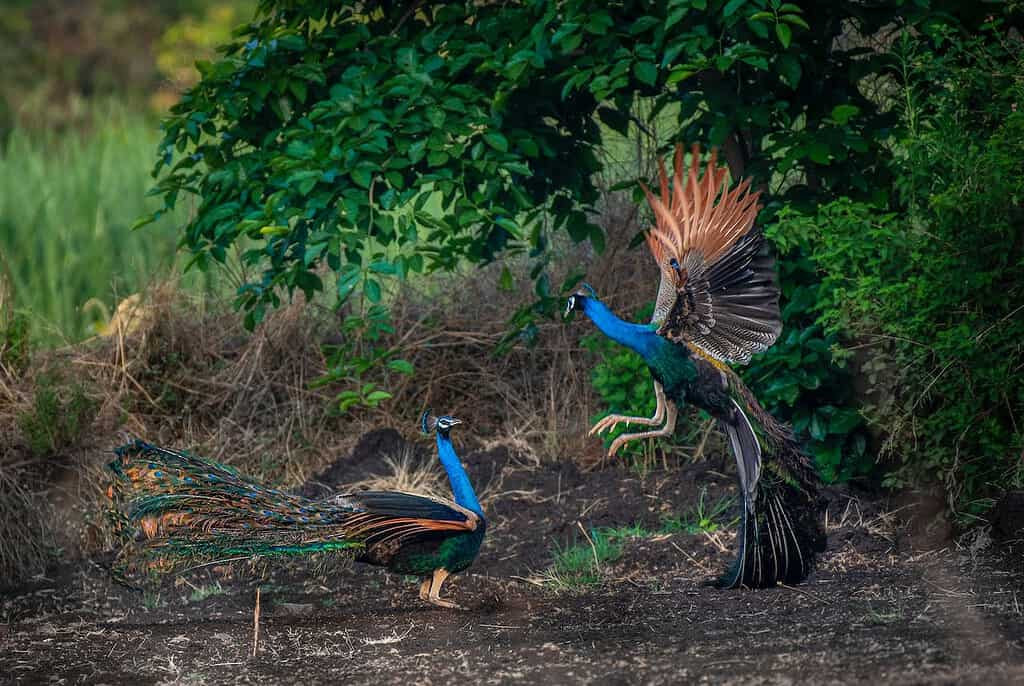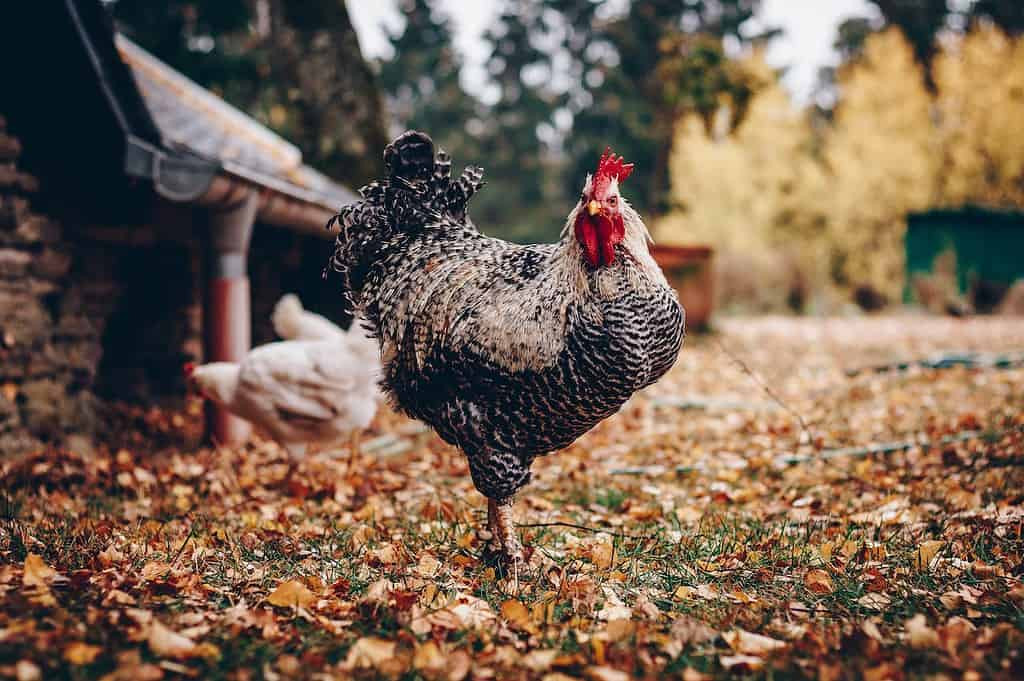Peacocks, with their iridescent plumage and stately demeanor, are often seen gracing gardens, parks, and even the occasional roadside. You’ve likely witnessed them strutting around, fanning their impressive tails, or perhaps even leaping onto low branches. But have you ever seen a peacock soaring high in the sky? The answer is probably no, and for good reason. While they possess wings, peacocks are not exactly known for their aerial prowess.
So, can peacocks fly? Yes, they absolutely can. Are they masters of the skies? Decidedly not. Peacocks are capable of flight, but they do so infrequently and not particularly well. In fact, flight occupies a mere fraction – around two percent – of their lives. And when they do take to the air, it’s less of a sustained flight and more akin to a powerful leap or glide. Unlike migratory birds or agile hunters of the sky, peacocks don’t fly for long distances or extended periods.
When a peacock does decide to fly, it’s usually for short bursts. The average peacock can cover a distance of approximately 300 meters, or about 1,000 feet. They also don’t achieve significant altitude. Think of it as more of an escape maneuver or a way to reach a slightly higher perch rather than a journey. While they might convincingly play the role of flightless birds most of the time, it’s more accurate to say that peacocks are just not very good at flying.
Peacock vs. Peafowl: Understanding the Terminology
Before we delve deeper into their flight limitations, let’s clarify some terminology. The term “peacock” is often used generically, but technically, it refers specifically to the male peafowl. Peafowl is the broader term encompassing both males and females. Female peafowl are called peahens. Therefore, all peacocks are peafowl, but not all peafowl are peacocks.
Peafowl exhibit sexual dimorphism, with males (peacocks) displaying vibrant plumage and females (peahens) having more muted colors. Image credits: Amol Mande.
This distinction is crucial because peafowl are sexually dimorphic, meaning males and females look different. This is particularly striking in the Indian peafowl (Pavo cristatus), the most common species. The dazzling blue peafowl we typically picture are indeed peacocks. Only the males boast the iconic train of iridescent feathers and the vibrant blue coloration. Peahens, in contrast, are rather plainly colored in muted browns and lack the elaborate tail feathers of the males.
Does the Peacock’s Train Hinder Flight?
A common assumption is that the peacock’s magnificent tail is the primary reason for their poor flight. It seems logical that such an extravagant and heavy train of feathers would be a significant impediment to aerial movement. However, while it might appear to be a hindrance, the impact of the train on flight is less than you might expect.
In nature, there’s often a trade-off between attracting mates and functional survival. This principle, known as sexual selection, was famously explored by Charles Darwin. Peahens are drawn to peacocks with elaborate plumage, meaning males with impressive trains are more likely to reproduce. This ensures the continuation of their genes and the flamboyant trait itself. From a reproductive standpoint, the train is a major advantage. However, this attractiveness comes at a potential cost. The elaborate plumage can be cumbersome, and in theory, might make peacocks more vulnerable to predators.
“The train of the peacock is one of the most iconic examples of sexual selection in the animal kingdom. It has been thought that such elaborate ornamentation carries a functional cost for the bearer. These results therefore have broader ramifications for evolutionary biology’s understanding of sexual selection,” explained Dr. Graham Askew, from the University of Leeds School of Biomedical Science.
Investigating Peacock Flight Mechanics and Sexual Selection
 A peacock displaying its full train of feathers, a result of sexual selection
A peacock displaying its full train of feathers, a result of sexual selection
Is limited flight ability the price peacocks pay for their ornate plumage, a feature driven by sexual selection? Image credits: Rajukhan Pathan.
To investigate the actual cost of the peacock’s train on flight, Dr. Askew and his team conducted a study on peacock flight mechanics. They used 3D video cameras to meticulously observe the flight of five blue peacocks.
“These feathers weigh about 300 grams and can exceed 1.5 meters, so it’s expected that the male birds would be making a significant sacrifice in their flight performance for being attractive — possibly giving up their lives if the train restricts escape from predators such as tigers and leopards in their natural environment,” Dr. Askew noted.
The high-speed cameras allowed the researchers to precisely measure the peacocks’ velocity at takeoff and the power of their wing strokes. Crucially, they recorded the peacocks flying both with and without their trains. To simulate the natural loss of the train after breeding season (molting), they carefully trimmed the feathers.
Surprisingly, the study revealed that the train had a negligible impact on the peacocks’ flight dynamics. The long, extravagant train of feathers, despite its size and apparent unwieldiness, is not the primary culprit behind their limited flight ability.
This unexpected finding is further reinforced by the fact that peahens, who lack the train, are also poor flyers. This suggests that the issue isn’t solely about the male’s ornamentation, but rather something fundamental to the entire peafowl species. The answer lies in their body shape and broader family classification.
The Pheasant Family Factor
Peafowl belong to the pheasant family, known scientifically as Phasianidae. This family encompasses a wide range of birds, including familiar species like chickens and turkeys. A defining characteristic shared by most pheasants is their preference for ground-dwelling and limited flight capabilities.
 A pheasant in its natural ground habitat
A pheasant in its natural ground habitat
Pheasants, like peafowl, are predominantly ground-dwelling birds with limited flight capacity. Image credits: J B.
Fun Fact: Many pheasant species exhibit sexual dimorphism, echoing the peafowl. The Himalayan Monal, for instance, showcases vibrant, blue-hued males and more subdued females, mirroring the peacock-peahen difference.
Think about chickens and turkeys – how often do you see them soaring through the sky? They are much more comfortable and adept on the ground. Similarly, peafowl, like other pheasants, primarily use flight for short bursts, vertical leaps, or escaping immediate danger. This ground-centric lifestyle is deeply connected to their physical build.
Pheasant Morphology: Built for the Ground
Pheasants, regardless of their specific size variations, are generally robustly built birds. They are heavier and lack the streamlined, aerodynamic body shape of birds built for sustained flight. Compare a falcon to a peacock: a falcon possesses a lean, proportionally balanced, and streamlined body. Its wings are slender and pointed, minimizing air resistance and enabling swift, sustained flight over long distances.
Peacocks, in contrast, have broader, rounder wings. This wing shape is better suited for quick bursts of power, ideal for short leaps and jumps, but not for prolonged flight. Essentially, pheasants, including peafowl, are simply not anatomically designed for extensive flying. In fact, some pheasants, like domestic chickens, have been selectively bred to be even closer to flightless, highlighting their natural predisposition towards a terrestrial existence.
 A close-up of a chicken, another member of the pheasant family known for limited flight
A close-up of a chicken, another member of the pheasant family known for limited flight
Chickens, like peafowl, are members of the pheasant family and are not adept flyers. Image credits: Photo by Kirsten Bühne.
In a LiveScience article, Michael Habib, a research associate at the Dinosaur Institute of the Natural History Museum in Los Angeles County, pointed out the extent of human influence on chicken flightlessness: “They’re so close to being completely flightless that you don’t necessarily have to put a roof over them to keep them in.”
Grounded, But Perfectly Adapted
While their limited flight might seem like a disadvantage in the avian world, it’s crucial to consider the habitats where pheasants thrive. They are not birds of open skies or coastal cliffs. Instead, they inhabit environments with dense vegetation, such as forests, grasslands, and agricultural areas. These habitats provide ample ground cover for foraging and are rich in resources. In such environments, long-distance flight for migration or foraging is not a necessity.
This is particularly true for peafowl in their natural and introduced ranges. They flourish in their ground-based existence. Peacocks haven’t needed to evolve into aerial masters; their survival and success are firmly rooted on the ground. Their limited flight capacity is not a deficiency, but rather an adaptation to a lifestyle where terrestrial prowess and striking visual displays are far more advantageous.
Related Posts
- The Golden Snub-Nosed Monkey — an adorable, threatened cold specialist
- Do we think in words or pictures?